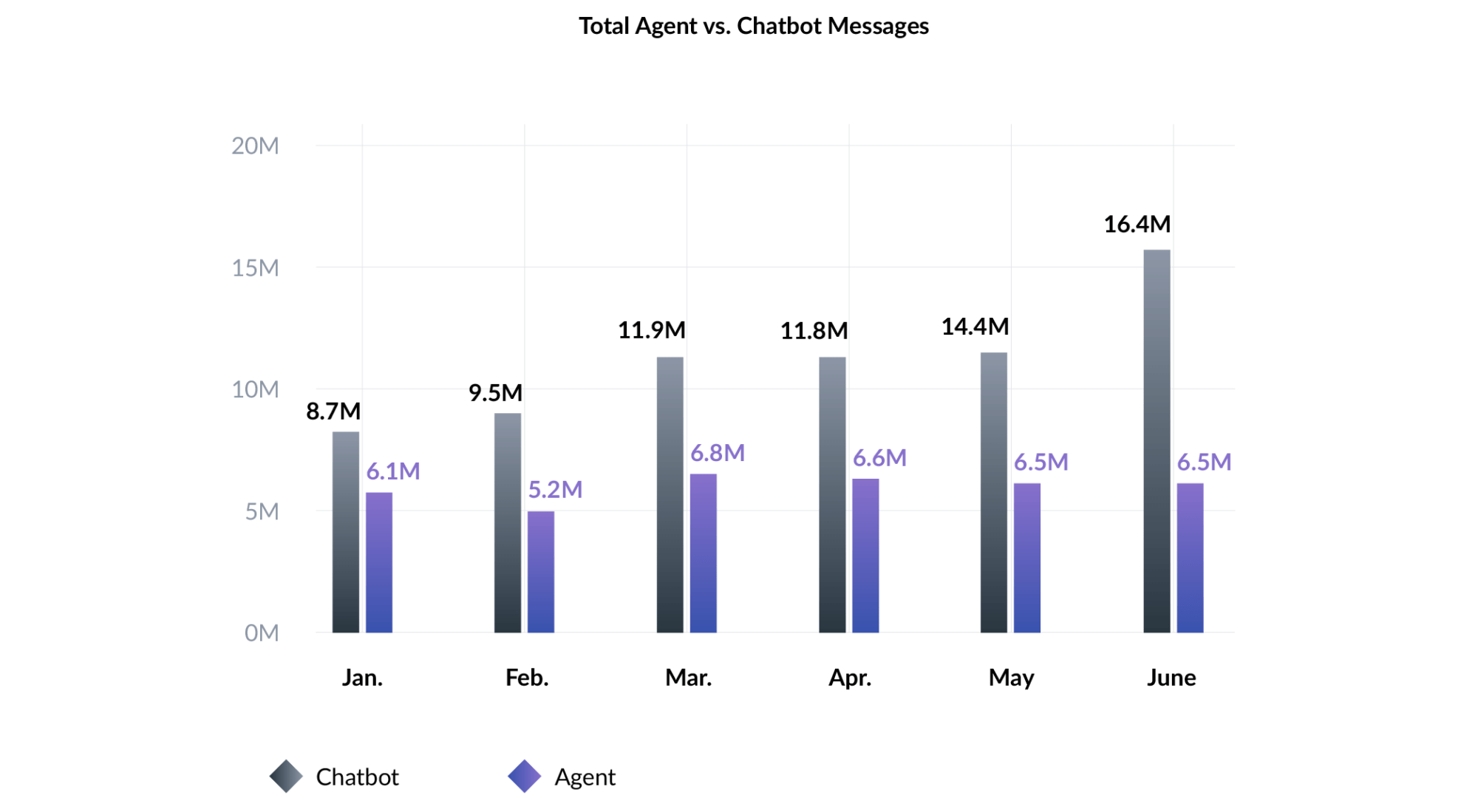The above chart shows that, of Helpshift customers, distinct messages sent by chatbots increased by 35% from Q1 to Q2. Meanwhile, agent outbound messages increased by only 8%. So even as issue volume rose dramatically, agents did not significantly increase their issue load.
The following is a guest post written by Jeff Saegner, VP of Customer Success, Helpshift
Customer support agents put up with a lot. You might have been in a situation where you felt the need to apologize to an agent for your mood — ‘I’m not annoyed with you, I’m frustrated with the situation.’ Most of the customer service agent’s job is to make us feel heard and valued as customers in moments when we’re not. But agents today don’t have a lot of time to spend empathizing with you, because they’re too busy gathering basic information about you and your problem. With little to go on, most agent interactions start with the most basic questions, whether that be asking a customer to verify their identity, provide an account number or (gulp!) ask a customer to repeat their issue after it’s been escalated.
As you know, Customer Satisfaction (CSAT) metrics are extremely sensitive to the quality of the agent interaction. When they perform well — solving issues with efficiency and empathy — CSAT goes up. When agents are overworked and unable to give the right amount of attention to each customer, CSAT goes down. When we talk about automation in customer service, we often discuss how this impacts the customer. Recent data from Helpshift shows that when bots and agents work together, CSAT is seven percent higher than when an agent or bot handles an issue solo. While this is great news for the customer, a deeper dive shows that agents are benefiting as well, by having more time to spend resolving customer problems. Here’s a closer look at our data and the story it tells about agents and bots working together to help customers.
Shorter hold times and ticket deflection
Helpshift data shows that 62 percent of people dread waiting on hold, and will put off calling customer support just to avoid doing so. And it’s not just on the phone. Even live chat requires customers to wait with a chat session open until an agent is available to respond. A new way to offer support is through asynchronous messaging, which allows customers to start a conversation and come back to it without losing the session — just like how they message their friends on their favorite messaging apps.
By pairing messaging with bots, response times are instant. Aside from replying instantly, bots do the rote work of gathering information for account access, identity verification, and issue classification before handing it to an agent. This warm handoff ensures that when an agent takes an issue, they have all the details they need to begin handling the customer’s issue immediately. And when bots are integrated into your back end systems to enable process automation, an agent might not even need to get involved at all. As a result, bot automation can deflect a big chunk of tickets from an agent’s queue, freeing up their time to focus on customer problems that really need their attention.
Sharing the workload
Our data shows quite dramatically how bots can handle an outsized portion of the support ticket workload. Over the last quarter, the number of overall messages sent by chatbots on the Helpshift platform increased 35 percent, while for agents there was only an increase of eight percent. The numbers are even more striking when looking at the average number of messages sent per ticket, with a nine percent increase for bots and a 13 percent decrease for agents. Bots are able to dramatically scale the number of tickets customer support teams can handle while simultaneously decreasing the number of messages agents need to send per ticket to resolve an issue — all while improving CSAT.
Support on the customer’s timeline
Automation empowers customers to seek help on their timeline, rather than planning their day around getting a problem resolved. Bots thrive in an asynchronous messaging environment where customers can begin a conversation and come back to it later. A bot won’t close out a session just because the person on the other end has stopped responding. And if a bot escalates an issue to an agent, the customer will receive a push notification so they can respond at a time that suits them best. All of this work happens entirely on the customer’s timeline — so they’re not left feeling like their time has been wasted. It’s no wonder then that CSAT is highest when agents and bots work together.
Compared to other channels, when bots augment the work of agents within a messaging environment it leads to a better experience for customers and a more efficient work experience for agents. Bots deflect a large number of tickets, so agents can focus on the most important ones. With fewer tickets to get through and with no customers waiting on hold, agents can take more time to provide a detailed and complete response to the customer, or even put processes in motion for resolution (such as issuing a refund) without making the customer wait. By the time the customer does come back to the chat, the only thing left to say might be ‘Thanks!’


